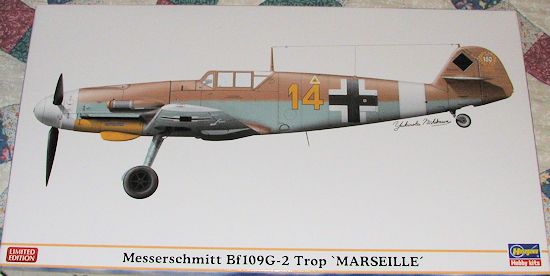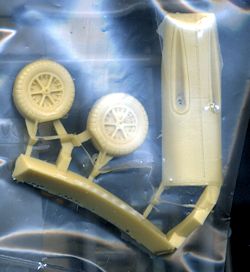
Hasegawa 1/48 Bf-109G-2/trop 'Marseille'
| KIT #: | 09952 |
| PRICE: | $24.99 on sale ($50.00 SRP) |
| DECALS: | One option |
| REVIEWER: | Scott Van Aken |
| NOTES: | 2011 limited edition with resin parts |

| HISTORY |
The G-2, which started production in May 1942, lacked the cabin pressurization and GM-1 installation. Performance-wise it was identical to the G-1. The canopy reverted to one layer of glazing and incorporated the angled head armour used on the F-4, although several G-2 had the vertical type as fitted to the G-1. Several Rüstsätze could be fitted, although installing these did not change the designation of the aircraft. Instead the "/R" suffix referred to the G-2's Rüstzustand or equipment condition of the airframe, which was assigned at the factory rather than in the field. There were two Rüstzustand planned for G-2s:
The rack and internal fuel lines for carrying a 300 L (80 US gal) under-fuselage drop-tank were widely used on G-2s, as were the underwing 20 mm MG 151/20 cannon gondolas. Several G-2s were fitted with the ETC 500 bomb rack, capable of carrying one 250 kg (550 lb) bomb. The final G-2 production batches built by Erla and Messerschmitt Regensburg were equipped as tropical aircraft (often referred to as G-2 trop), equipped with a sand-filter on the front of the supercharger intake and two small, teardrop-shaped metal brackets on the left side of the fuselage, below the cockpit sill. These were used as mounts for specially designed sun umbrellas (called Sonderwerkzeug or Special tool), which were used to shade the cockpit.
A total of 1,586 G-2s were built between May 1942 and February 1943, and one further G-2 was built in Győr, Hungary, in 1943. Maximum speed of the G-2 was 537 km/h (334 mph) at sea level and 660 km/h (410 mph) at 7,000 m (22,970 ft) rated altitude with the initial reduced 1.3 atm rating. Performance of the G-1 was similar, but above rated altitude the GM-1 system it was equipped with could be used to provide an additional 350 horsepower. With his G-1/R2, pilot R. Klein achieved 660 km/h (420 mph) at 12,000 m (39,370 ft), and a ceiling of 13,800 m (45,275 ft).
The following variants of the G-2 were produced:
To many enthusiasts, it was the 109G-2/trop that killed 'The Star of Africa', Hans-Joachim Marseille, when its engine developed major trouble and started slowing down and smoking profusely. After exiting the smoke-filled cockpit, Marseille's chest struck the vertical stabiliser of his aircraft, either killing him instantly, or incapacitating him so that he was unable to open his parachute.
| THE KIT |
 Basically
this is a kit of Marseille's last aircraft. It is pretty much standard
Basically
this is a kit of Marseille's last aircraft. It is pretty much standard
 Hasegawa
109G, which means it has all the bits of the F along with the pieces needed to
make the G. Since the earlier G-2 kits had the wrong wheels and upper cowling,
Hasegawa has included those pieces in resin.
Hasegawa
109G, which means it has all the bits of the F along with the pieces needed to
make the G. Since the earlier G-2 kits had the wrong wheels and upper cowling,
Hasegawa has included those pieces in resin.
The Hasegawa 1/48 Bf-109 series is still widely regarded, despite other 109F/Gs being released by other companies. The kit is well engineered and has detail enough to satisfy most modelers. It has a fairly complete cockpit, lacking only a harness of some sort to make it look really good. There is raised instrument panel detail over which one can place the included decal. Sidewall detail is also rather nice, though to be honest, resin cockpit replacements up the detail to the next level and are recommended for those who want the additional detail.
Some of the other features of the kit are separate
flaps that can be posed lowered and the wing radiator coolant flaps that are
separate and can be posed in several different positions. When you have a 'one
fuselage fits all' way of doing kits, you'll not be surprised that you have to
fill in a few holes and engraved detail. You'll also need to take the F wings,
open up the wheel wells, and scribe in a panel line. No big deal for those of us
who have built quite a few of these and easy enough. The kit a lso
includes several drop tanks, though Marseille's planes were often photographed
without the tank or rack. The cockpit transparency can be displayed open or
closed as one wishes.
lso
includes several drop tanks, though Marseille's planes were often photographed
without the tank or rack. The cockpit transparency can be displayed open or
closed as one wishes.
The instructions are typical Hasegawa with Gunze paint references. The lone markings option is for Marseilles' plane in RLM 78/79 with white nose, fuselage band, and wing tips. The decals are very well done and depict his plane with the final score on it. Additional decals are provided for his Kubelwagen, though you'll have to scrounge photos to duplicate this one.
| CONCLUSIONS |
To be honest, I have a ton of Bf-109s in my stash, but am sorely lacking the early G models. My first Hasegawa 1/48 Bf-109 kit was their F-4 variant, which I did in Marseille's markings, so I am not in need of the kit for that reason. The G-2 was fairly widely used, though rather quickly superseded by the G-4 and then the type that was built more than any, the G-6. This is a nice kit and for those who can find it on sale, it is very much worth picking up.
| REFERENCES |
http://en.wikipedia.org/wiki/Messerschmitt_Bf_109_variants#Bf_109G
November 2013 Thanks to your editor for
grabbing this kit on
sale If you would like your product reviewed fairly and fairly quickly, please
contact
the editor
or see other details in the
Note to
Contributors.